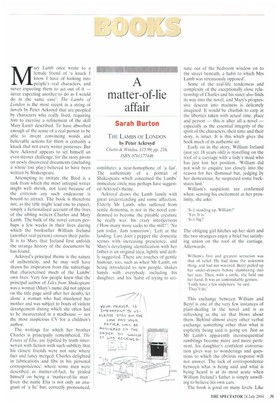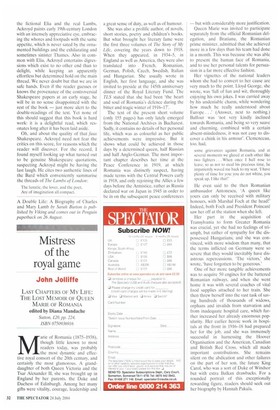A matter-of-lie affair
Sarah Burton
THE LAMBS OF LONDON by Peter Ackroyd Chant, & Windus, .f15.99, pp. 216, ISBN 0701177446 Mark' Lamb once wrote to a female friend of 'a knack I know I have of looking into people's real characters, and never expecting them to act out of it — never expecting another to do as I would do in the same case'. The Lambs of London is the most recent in a string of novels by Peter Ackroyd that are peopled by characters who really lived, requiring him to exercise a refinement of the skill Mary Lamb described. To have absorbed enough of the sense of a real person to be able to invent convincing words and believable actions for them is certainly a knack that not every writer possesses. But here Ackroyd appears to set himself an even sterner challenge, for the story pivots on newly discovered documents (including a whole lost play) believed to have been written by Shakespeare.
Attempting to imitate the Bard is a task from which the most intrepid writer might well shrink, not least because of the criticism any such endeavour is bound to attract. The book is therefore not, as the title might lead one to expect, simply a fictionalised account of the lives of the sibling writers Charles and Mary Lamb. The bulk of the novel covers perhaps a few weeks in their lives during which the bookseller William Ireland (another real person) crosses their paths. It is to Mary that Ireland first unfolds the strange history of the documents he has found.
Ackroyd's principal theme is the nature of authenticity, and he may well have drawn his inspiration from the subterfuge that characterised much of the Lambs' own lives. Very few people knew that the principal author of Tales from Shakespeare was a woman (Mary's name did not appear on the title page until after her death), let alone a woman who had murdered her mother and was subject to bouts of violent derangement during which she often had to be incarcerated in a madhouse — not the most auspicious CV for a children's author.
The writings for which her brother Charles is principally remembered, The Essays of Elia, are typified by truth interwoven with fiction with such subtlety that his closest friends were not sure where fact and fancy merged. Charles delighted in fabrications and fibs in his personal correspondence: where some men were described as matter-of-fact, he prided himself on being a 'matter-of-lie man'. Even the name Elia is not only an anagram of 'a lie' but, correctly pronounced, constitutes a near-homophone of 'a liar'. The authenticity of a portrait of Shakespeare which concerned the Lambs' immediate circle may perhaps have suggested Ackroyd's theme.
Ackroyd draws the Lamb family with great understanding and some affection. Elderly Mr Lamb, who suffered from senile dementia, is not in the novel condemned to become the pitiable creature he really was: his crazy interjections ('How many more sacks to the mill?'; `No jam today. Jam tomorrow'; 'Left at the landing. Last door') pepper the domestic scenes with increasing prescience, and Mary's developing identification with her father is an original idea, lightly and deftly suggested. There are touches of gentle humour, too, such as when Mr Lamb, on being introduced to new people, shakes hands with everybody including his daughter, and his 'habit of trying to uri nate out of the bedroom window on to the street beneath, a habit to which Mrs Lamb was strenuously opposed'.
Some of the real-life tenderness and complexity of the exceptionally close relationship of Charles and his sister also finds its way into the novel, and Mary's progressive descent into madness is delicately imagined. It would be churlish to carp at the liberties taken with actual time, place and person — this is after all a novel — especially as the essential integrity of the spirit of the characters, their time and their story, is intact. It is this which gives the book much of its authentic air.
Early on in the story, William Ireland (not yet 18 years old) is travelling on the roof of a carriage with a lady's maid who has just lost her position. 'William did not wish to enquire too closely into the reason for her dismissal but, judging by her demeanour, he suspected some backstairs lust.'
William's suspicions are confirmed when, sensing his excitement at her proximity, she asks:
'Is it standing up, William?' 'Yes. It is.'
'Is it big?'
The obliging girl hitches up her skirt and the two strangers enjoy a brief but satisfying union on the roof of the carriage. Afterwards,
William's first and greatest sensation was that of relief. He had done the unknown thing, and had not wavered. Beryl pulled up her under-drawers before clambering into her seat. Then, with a smile, she held out her hand. It was an unmistakable gesture.
only have a few sixpences,' he said.
'They'll do.'
This exchange between William and Beryl is one of the very few instances of plain-dealing in the novel and is as refreshing as the air that blows about them. Behind almost every other verbal exchange something other than what is explicitly being said is going on. Just as Mr Lamb's apparently inconsequential ramblings become more and more pertinent, his daughter's confident conversation gives way to wonderings and questions to which the obvious response will not answer. The lack of correspondence between what is being said and what is being heard is at its most acute when William Ireland's father is simply unwilling to believe his own ears.
The book is good on many levels. Like the fictional Elia and the real Lambs, Ackroyd paints early 19th-century London with an intensely appreciative eye, embracing the whores and footpads with the same appetite, which is never sated by the ornamented buildings and the exhilarating and sometimes sinister Thames. Also in common with Elia. Ackroyd entertains digressions which exist to no other end than to delight, while keeping an apparently effortless but determined hold on the main thread. We never doubt but that we are in safe hands. Even if the reader guesses or knows the provenance of the controversial Shakespeare papers at an early stage, he will be in no sense disappointed with the rest of the book — just more alert to the double-readings of the text. Yet none of this should suggest that this book is hard work: it is a delightful read, which resonates long after it has been laid aside.
Oh, and about the quality of that faux Shakespeare. Ackroyd need not fear the critics on this score, for reasons which the reader will discover. For the record, 1 found myself looking up what turned out to be genuine Shakespeare quotations, suspecting Ackroyd might be having the last laugh. He cites two authentic lines of the Bard which conveniently summarise the threads of The Lambs of London:
The lunatic, the lover, and the poet, Are of imagination all compact.
A Double Life: A Biography of Charles and Mary Lamb by Sarah Burton is published by Viking and comes out in Penguin paperback on 26 August.



























































 Previous page
Previous page